|
BEFORE HE FLED FROM HIS FATHER IN EBURACUM (YORK) JESUS CONSTANTINE HAD A
SON NAMED JESUS CRISTUS WITH HIS WIFE/CONCUBINE NAMED MINERVINA.
|
|
The Greek word CRISTOS is a TITLE and equivalent to the Hebrew word MESSIAH.....The English word Christ is transliterated from the Greek Cristos, Christus in German, Christ in French, Cristo in Italian and Spanish....The classical Latin transliteration of the Greek CRISTOS is CRISTUS.
The Great Apostasy predicted by the Apostle Paul, and the rise of Antichrist predicted by the Apostle John, began in the wilderness—at the most remote outpost of the Roman Empire (II Thessalonians 2:3, Apocalypse 17:3).
There is nothing new under the sun (Ecclesiastes 1:19). Satan's template for creating the New Covenant apostasy was based on the Babylonian King Nimrod marrying his mother Queen Semiramis, and having a son named Tammuz (Genesis 10:9, Ezekiel 8:14). That is why Saint Martin Luther entitled his 1620 magnum opus: On the Babylonian Captivity of the Church....That brilliant and prolific author calculated that the Babylonian Captivity began around 260 (260+1260=1520).
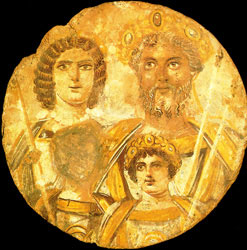
Cameo of Julia
Domna, Caesar,
and their surviving son Caracalla. |
| |
Eburacum
was the remotest outpost of the Roman Empire in Britannia.
It
was inhabited by wild men called Brigantes, who were ruled by
women; painted their bodies, stripped for battle, and married their mothers (Leviticus 18:7).
In
early 208, Eburacum had a most unexpected visitor: the mighty Roman Emperor Septimius Severus "Severe Seven."
Caesar was accompanied by his wife/boss Julia Domna, and rival sons Caracalla and Geta.
|
|
|
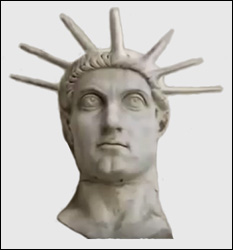
Emperor Jesus Constantine (272–337). Misruled from 306 to 337. |
Septimius
Severus was known as the "African Emperor" as he was a Carthaginian
Canaanite. The
Carthaginians were the deadly enemies and rivals of Roma for centuries. Femme
fatale Julia Augusta was also a Canaanite and Jezebel on
steroids!
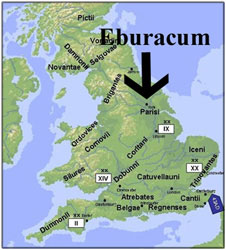
The Roman fortress Eburacum
is now called York. |
| |
The Romans ruled Britannia for 3 centuries, yet few visible traces of their presence can be found.
Londinium was founded by Emperor Claudius, and Emperor Hadrian built a huge wall across the northern part of the island.
Hadrian's Wall required the presence of many legions (St. Mark 5:9) so the Latin language predominated.
|
|
|
 Panoramic view of York, England, with
the cathedral in the center. |
Saint Patrick's ancestors were Christian Roman Britons who fled to the north of the island during the great persecution of Emperor Diocletian.
While Caesar Septimius Severus was fighting 'barbarians," his wife Julia was having sex with her son Caracalla. The baby she left behind became the grandfather of Esus Constantinius Clorus.
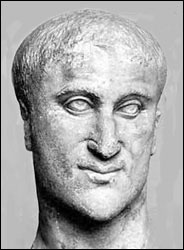
Esus Constantinus Clorus (
245–306)
was the father of Jesus Constantine. |
| |
The
baby born to Julia Domna in Eburucum was adopted by a Roman Tribune
named Esus Constantinus.
Constantinus was the father of Esus Constantinius Clorus.
In
212, Caracalla gave Roman citizenship to all free men and
women in the Empire.
Around
272, Constantinus Clorus married Druidess Helena. |
|
|

No image exists of Helena
in Britannia. |
According to "historian" Edward Gibbon, Helena was a Balkan barmaid. In the Roman Empire, lupa (she-wolf) and barmaid were slang words for prostitutes. Another legend has Helena the daughter of "Old King Cole."
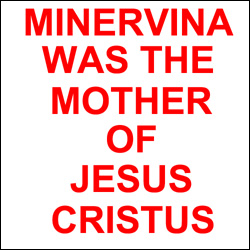
No portrait or statue of
Minervina exists. |
| |
Before he left Britannia, Constantine had a son named Cristus with HIS wife/concubine named Minervina.
While he was there, Diocletian launched the last great pagan persecution of the Christians, which lasted 10 years (Apocalypse 3:2).
Millions of books were burned, and the primary target was the Holy Scriptures. |
|
|
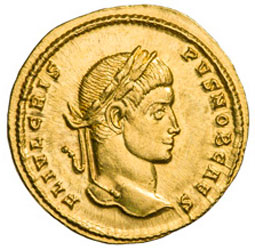
Coin of Jesus Cristus (295–326) son
of Jesus Constantine and Minervina.
|
Even anti-Christian pagan books were burned because they would reveal the true name of the Messiah. Constantine made sure that all Scriptures that condemned "kissin' cousins," or his depraved lifestyle, were consumed in the Empire-wide holocaust.
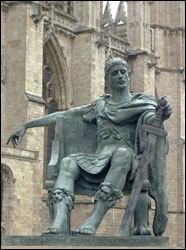
Jesus Constantine's statue at the
cathedral in York. |
| |
During the persecution in the East, Constantine "escaped" from the Court of Diocletian. Later hagiographers compared that flight to Moses escaping from Pharaoh.
In 305, Constantine arrived back in Eburacum, and the following year he sent his father to Hades.
After the untimely death of his father, he was proclaimed Caesar by his troops.
|
|
|
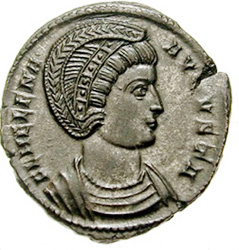
Coin of Helena Augusta. Mother/wife
of Emperor Constantine. |
To cement his claim to the throne he married Helena, and adopted Cristus as his son and heir! Helena became Augusta when she married her son....Augusta was a title reserved exclusively for wives of Roman Emperors.
With his mother/wife by his side, and accompanied by his son Cristus, Constantine set out to conquer the entire Roman Empire. His final goal was to impose his version of "Christianity" on the whole world.....Before Constantine it was illegal to be a Christian . . . now it would be illegal not to be a Christian.
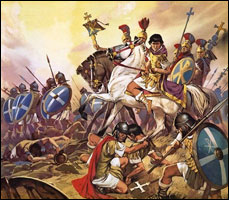
The Battle of Milvian Bridge. |
| |
Jesus Constantine, and his army of 80,000 naked Brigantes appeared before the walls of Roma in October 312.
At noonday, before the battle commenced, he claimed to have seen a vision of a cross in the sky, and a voice that said In Hoc Signo Vinces or "with this sign, conquer."
That was a counterfeit of Saint Paul's conversion on the Damascus Road, when at noonday he saw a light BRIGHTER than the sun (Acts 22:6). |
|
|
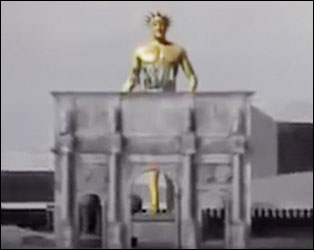
A lofty statue of Constantine as Apollyon
towered over the arch of Constantine.
|
After Constantine conquered the entire Roman Empire, he called the Council of Nicaea to resolve disputes among the Christians about the true nature of Christ. Was he created . . . or did he always exist?
The Council of Nicaea was held just before the 300th anniversary of the death and Resurrection of the Messiah. For the first 300 years, the Scriptures were the sole guide for Christians on all matters of faith and morals.
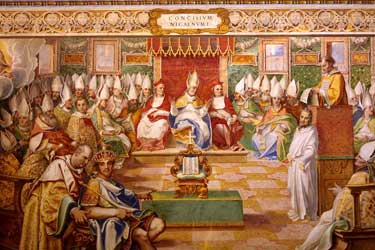
A 16th-century fresco depicting the Council of
Nicaea held in 325 AD. |
| |
Counterfeit Christian Jesus Constantine presided as "bishop" over the Council of Nicaea.
The burning issue was the true nature of the Cristos or Cristus.
Most of the Bibles were burned during the great persecution so Constantine told them what to believe.
Naturally, Constantine believed that his son Cristus was the Messiah. |
|
|
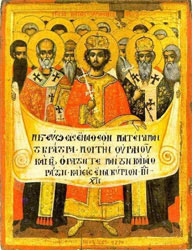
Icon depicting Emperor Constantine
and
the bishops at the Council of Nicaea.
|
During the Council a new calendar was adopted which began at 5508 BC, and the date for Passover-Resurrection was changed to the corrupt Latin computation.
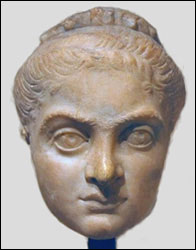
Flavia Maxima Fausta (289-326)
was killed by Constantine. |
| |
Helena was the only wife Constantine recognized, but most Romans objected to his incestuous marriage.
As a result, he married a woman named Flavia Fausta, who bore him 3 sons and 2 daughters.
Fausta wanted her firstborn son to succeed as Emperor, so she accused Cristus of trying to seduce her.
As a result, Constantine ordered the execution of Cristus . . . and then he murdered Fausta. |
|
|
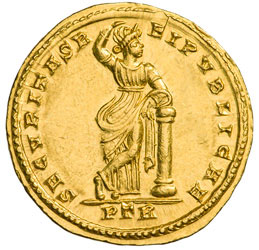
Reverse of coin of Jesus Cristus with
the words "the security of the Republic." |
Naturally, Helena was also anxious to get rid of Fausta.....The death of Cristus, on the 300th anniversary of Christianity, was also a parody of the death of the real Cristus.
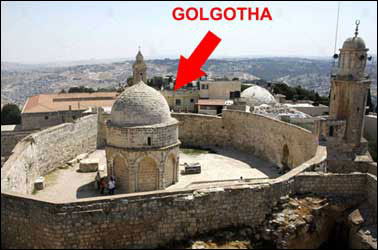
The Empty Tomb was situated
on the Mount of Olives! |
| |
As "penance" for the deaths of Cristus and Fausta, Constantine sent his mother to Jerusalem to discover the True Cross.
Amazingly, she discovered the True Cross at the site of the future fake "Holy Sepulchre."
That "Holy Sepulchre" is still a bone of contention between the Latin West and the Orthodox East. |
|
|
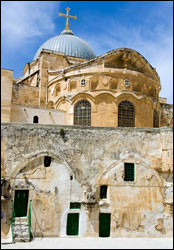
The fake Golgotha or tomb
of Christ. |
With gold and silver confiscated from the pagan temples, Constantine went on a building spree, erecting "Christian" houses of worship all over the Empire. He constructed the Lateran Palace in Roma, and he also built a tomb to house his remains, and those of his mother/wife Helena. Prior to Constantine, Roman Emperors were cremated!
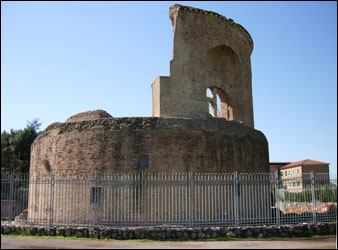
The mausoleum of Helena at Roma was originally
built for Constantine and his mother/wife Helena. |
| |
The monster Nero killed his own mother Agrippina because she refused to marry him!
The SPQR Romans did not want Constantine in their city because they still despised his marriage to his mother.
The Senate also refused to make him a king because kings were banned forever in 509 BC.
As revenge for not allowing him to be buried in Roma, Constantine founded the Papacy under Pope Julius I.
|
|
|
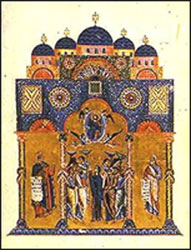
Church of the Holy Apostles;
former tomb of Constantine. |
Helena Augusta went to Hades in 330, and she was buried in the huge mausoleum that was built for both of them. Like all his deluded followers today, Jesus Constantine believed that the waters of baptism would wash away his many sins.....That was why he delayed baptism until just before his death.
He was buried in Constantinople, in a massive building called the Church of the Holy Apostles; surrounded by images of the 12 Apostles of Christ. In 1453, that church was demolished by the Terrible Turks, and turned into a mosque. No one knows where his bones lie, but perhaps Apollyon has one more mission for Jesus Constantine before the end of time.
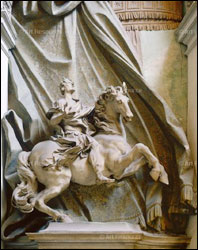
Equestrian statue of Emperor Jesus
Constantine in St. Peter's Basilica. |
| |
Saint John saw a frightening vision of the 4 Horseman of the Apocalypse, and they were led by a rider on a White Horse.
That rider was/is Emperor Jesus Constantine.
Then John was taken to the wilderness and he saw a vision of a woman sitting on a scarlet colored beast with 7 heads and 10 horns.
That woman was/is Empress Helena. |
|
|
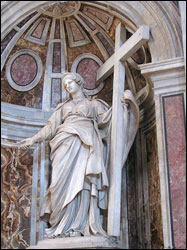
Statue of
"Saint" Helena in
St. Peter's Basilica.
|
Pope Julius I did not want the new "Christian" city associated with its pagan past, so he changed Romulus and Remus to Saints Peter and Paul.
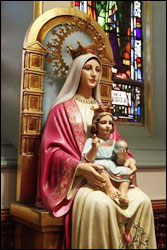
Statue of "Virgin" Helena holding the
infant Cristus in St. Peter's Basilica. |
| |
The "Virgin" mother of Christ that is the main focus of Catholic worship is actually Helena the mother/wife of Constantine.
That is why they can claim to follow Christ, but their "Christ" is actually the Latin Cristus.
The Orthodox Church in Constantinople enthusiastically embraced Constantinian "Christianity," but they only accepted the decrees of the first 7 ecumenical councils.
|
|
|
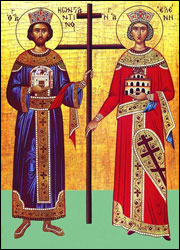
Orthodox icon of "Saint" Constantine
with his mother/wife "Saint" Helena. |
That means that they totally rejected the idea of pick-pocket "Purgatory," or a second chance to be saved after death!
Fulfilled prophecy is one of the greatest proofs that the Bible is true:
And now I (Christ) have told BEFORE it comes to pass, that WHEN it comes to pass, ye might believe (Saint John 14:29).
The Alpha and Omega not only predicts the future but he give the time frame when the prophecies would come to pass!
The real Saint Peter also stressed the infallible words of prophecy:
We also have a more sure word of prophecy, which ye do well to take heed as a light that shines in a dark place, until the day dawns, and the morning star rises in your hearts (II Saint Peter 1:19).
Jackass "historians" changed the name CRISTUS to CRISPUS....Changing one letter in a name can cause chaos and deceive millions....In 1066, Anglo-Saxon
King HAROLD was killed by Viking King HARALD of Norway....Change one letter in LUTHER and you can spell HITLER... Change one letter in GOD and it spells GOG.....Change one letter in ROMA and it spells ROME.
The biggest spelling mistake of all is the change of the name of the Jewish Messiah:
I am ALPHA and OMEGA, the beginning and the ending, saith JEHOVAH, who is and who was and who is to come, the Almighty (Apocalypse I:8, 1:11, 21:6, 22:13).
References
Baynes,
Norman, H. Constantine the Great and the Christian Church. London,
1934.
Birley, Anthony R. Septimius Severus: The African Emperor. Yale University Press, New Haven, Connecticut, 1972.
Burckhardt,
Jacob.The Age of Constantine the Great. Pantheon Books Inc.,
New York, 1949.
Eusebius
Pamphili, (260–340), Preparation
for the Gospel, Proof of the Gospel, Ecclesiastical History,
Life of Constantine, Oration to Constantine, etc., etc. Grand Rapids,
Baker Book House, 1981.
Gibbon,
Edward. The History of the Decline and Fall of the Roman Empire (in 6 volumes). Methuen & Co., London, 1909.
Kee,
Alistair. Constantine Versus Christ: The Triumph of Ideology. SCM Press, London, 1982.
MacMullen,
Ramsey. Constantine. The Dial Press, New York, 1969.



 Panoramic view of York, England, with
Panoramic view of York, England, with 

















